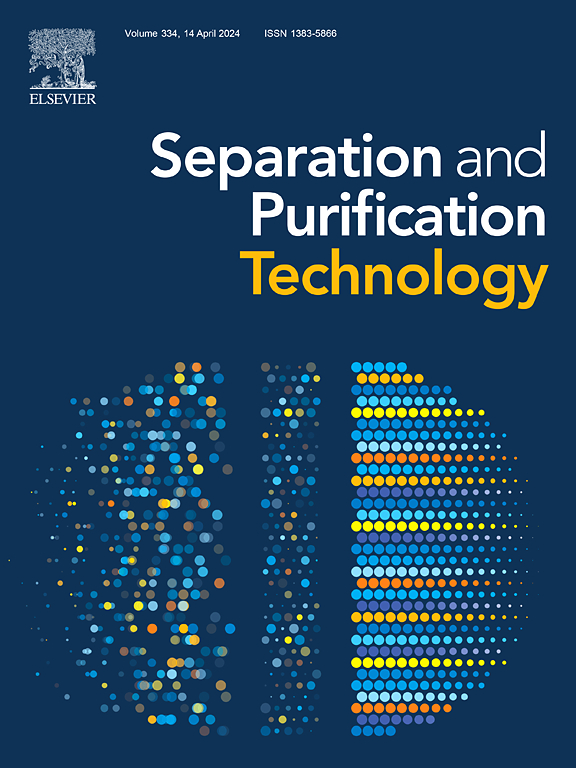磷酸盐和胍改性偕胺肟聚丙烯腈复合纤维用于海水高效、选择性提铀
IF 9
1区 工程技术
Q1 ENGINEERING, CHEMICAL
引用次数: 0
摘要
随着核能需求的不断增长,常规铀储量正在枯竭,从海水中提取铀成为一个重要的研究领域。因此,开发高性能吸附材料至关重要。在以往的研究中,聚丙烯腈-偕胺肟聚丙烯腈纤维(PAN-PAO)是通过湿纺丝技术制备的。在此基础上,以聚己亚甲基双胍(PHMB)和磷酸三钠(TSP)为原料,引入偕胺肟、胍和磷酸官能团,经水热合成法合成了新型复合纤维吸附剂PAN-PAO-OH-B-T。PAN-PAO-OH-B-T纤维在多个官能团的作用下表现出协同铀结合的特性,吸附量达到1350 mg/g,选择性系数达到20.6。吸附动力学符合拟二阶模型,Langmuir等温线很好地描述了平衡数据,理论最大容量为2058 mg/g。在重复使用方面,连续6次循环后,纤维的吸附容量为1310 mg/g,解吸率为91.4 %。此外,胍类功能的掺入增强了抗菌性能,细菌抑制率超过90% %,并大大降低了藻类的粘附。在天然海水中暴露28 天后,PAN-PAO-OH-B-T纤维的铀吸收率达到了9.66 mg/g,显示出在海水中铀回收的实际应用前景。本文章由计算机程序翻译,如有差异,请以英文原文为准。

Anti-biofouling amidoxime polyacrylonitrile composite fibers modified with phosphate and guanidine for efficient and selective uranium extraction from seawater
With the escalating demand for nuclear energy, conventional uranium reserves are being depleted, making uranium extraction from seawater a key research area. Therefore, the development of high-performance adsorbent materials is crucial. In previous studies, polyacrylonitrile-amidoxime polyacrylonitrile fibers (PAN-PAO) were fabricated via a wet-spinning technique. Building on this foundation, a novel composite fiber adsorbent, designated PAN-PAO-OH-B-T, was synthesized through hydrothermal modification using polyhexamethylene biguanidine (PHMB) and trisodium phosphate (TSP), thereby introducing amidoxime, guanidine, and phosphate functional groups. The PAN-PAO-OH-B-T fibers exhibited synergistic uranium binding enabled by the multiple functional groups, achieving a high adsorption capacity of 1350 mg/g and an elevated selectivity coefficient of 20.6. Adsorption kinetics followed a pseudo-second-order model, and equilibrium data were well described by the Langmuir isotherm, with a theoretical maximum capacity of 2058 mg/g. In terms of reusability, the fibers retained an adsorption capacity of 1310 mg/g with a desorption rate of 91.4 % after six successive cycles. Additionally, the incorporation of guanidine functionalities enhanced antibacterial properties, with a bacterial inhibition rate exceeding 90 %, and substantially reduced algal adhesion. After 28 days of exposure to natural seawater, the PAN-PAO-OH-B-T fibers achieved a uranium uptake of 9.66 mg/g, demonstrating significant promise for practical applications in seawater uranium recovery.
求助全文
通过发布文献求助,成功后即可免费获取论文全文。
去求助
来源期刊

Separation and Purification Technology
工程技术-工程:化工
CiteScore
14.00
自引率
12.80%
发文量
2347
审稿时长
43 days
期刊介绍:
Separation and Purification Technology is a premier journal committed to sharing innovative methods for separation and purification in chemical and environmental engineering, encompassing both homogeneous solutions and heterogeneous mixtures. Our scope includes the separation and/or purification of liquids, vapors, and gases, as well as carbon capture and separation techniques. However, it's important to note that methods solely intended for analytical purposes are not within the scope of the journal. Additionally, disciplines such as soil science, polymer science, and metallurgy fall outside the purview of Separation and Purification Technology. Join us in advancing the field of separation and purification methods for sustainable solutions in chemical and environmental engineering.
 求助内容:
求助内容: 应助结果提醒方式:
应助结果提醒方式:


